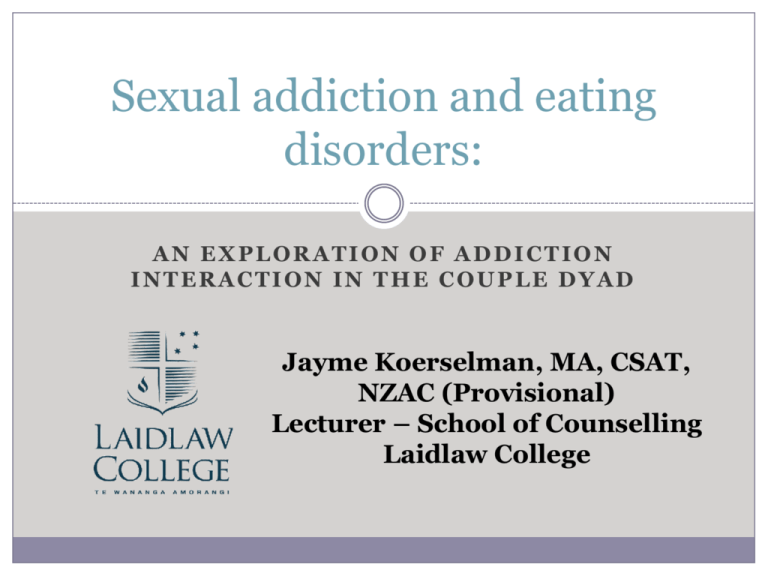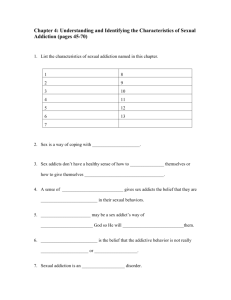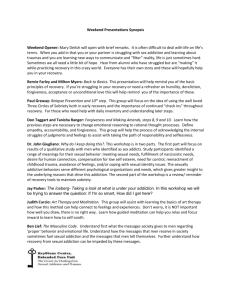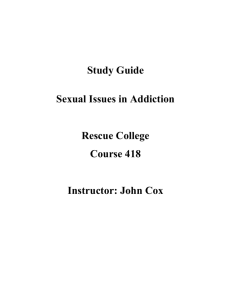
Sexual addiction and eating
disorders:
AN EXPLORATION OF ADDICTION
INTERACTION IN THE COUPLE DYAD
Jayme Koerselman, MA, CSAT,
NZAC (Provisional)
Lecturer – School of Counselling
Laidlaw College
Addictions defined - Sex
Controversial term especially in the area of sex and
eating
“Out of control behavior” (Carnes, 1992, 2001)
Both binging and restricting – “Sexual Anorexia” (Carnes, 1997;
Nelson, 2003)
Sexual compulsivity (Quadland, 1985) or impulsivity (Barth &
Kinder, 1987)
Sexologists have been more reluctant to accept this
terminology instead using the DSM IV terminology
hypersexuality and hyposexuality (Kaplan, 1995)
Addictions defined - Eating
“Vandereycken (1990) cautions against bulimia being a form of
addiction in spite of the similarities to other addiction as he
states this is mainly based on analogy only and clinicians (and
patients!) wanting to reassure each other of a known entity. He
goes on to say it’s important to look at what is similar but also
what is dissimilar between eating disorders and addiction.
Addiction model of eating disorders see Handbook of
Addiction Disorders (Coombs, 2004)
Addictions defined
For the purpose of our discussion addiction is
defined as:
Loss of control of behavior
Behavior continues in spite of significant consequences
Preoccupation with the behavior or preparation of it
Distress, anxiety, irritability if unable to engage in the behavior
(Carnes, 2001: Goodman, 1993, 1998)
The cycle of destructive thoughts and behavior that
affect mind, body, and relationships
Self/Couple
concept &
beliefs
Restriction/
Compensatory
Physical and
emotional
consequences
Preoccupation
Life consequences/
Unmanageability
Ritualization
Acting out
How this became an interest
Clinical observation
Case examples
Common Characteristics
Addiction parallels and interaction (Carnes, 2005; Petrucelli
& Stuart, 2001; Orford, 2001; Huebner, 1993)
Carnes (2005) describes “the understanding of excessive
behaviors as addictive disorders that share similar features,
causes, and even cures. As part of that clarification we are
proposing a model that integrates the addictions and proposes
that the addictions have metapatterns that are important and
discernable clinically” (p. 87).
How this became an interest
Professional studies/Literature Reviews
Attachment styles
Addiction characteristics
Neurobiological aspects
Studies of differentiation – Bowen, Winnicott, Sullivan,
Schnarch, Bowlby
Relational anthropology
Common Characteristics
Process addictions (Power, 2005)
“Series of events repeated in the course of acting out selfdestructive patterns” (Glass, 2011).
Addictive cycle
Problem of desire – “Appetites” (Knapp, 2003)
“In short, the things we once needed in order to survive—food,
shelter, intimate partnerships—have become the things we
want in order to feel sated. But satiety is itself a tricky subject,
in large part because our culture—visual, commercially
rapacious, oriented toward quick fixes and immediate
gratification—both fuels and defines the wish for it at almost
every turn, on almost every front.”
Common Characteristics - Problem of Desire
“They [women] value their independence and find it difficult to
bond with another person. They are afraid of their dependency
needs, of becoming vulnerable in a love relationship. In this age,
it is easy to turn to something impersonal, non-demanding and
seemingly free from conflict—something like food, the new lover.
Food as a lover is always there. It accepts them unconditionally
they do not have to pencil it into their appointment books or
worry about herpes or AIDS. But just as a lover can bring them
satisfaction and unhappiness simultaneously, so, too, can food
bring emotional upheaval—the dilemma we have mentioned: to
eat is to be thin and happy or fat and sad.” (Meadow, 1992)
“Not wanting to want and wanting to be wanted” - (Schnarch,
1991)
Common Characteristics
Relational disorders
Bulimics in particular tend to show a high selfconsciousness and inability to enjoy sex yet have a
prevalence to be hypersexual (Schembri & Evans, 2008;
Rodríguez et al., 2007; Pinheiro, et al., 2009) which
suggests that they may use sexual activity as a means of
relational security and approval (Culbert & Klump,
2005).
Similarly, sex addicts often objectify and avoid any
meaningful intimacy in sexual encounters.
“Other-centered validation” (Schnarch, 1991)
Common Characteristics – Relational disorders
Attachment styles
Perceive families as rigid and disengaged (Waller,
Slade, & Calam, 1990; Carnes, 1992)
Both individuals struggling with sex addiction and
eating disorders have been linked to an insecure
attachment – specifically highly anxious and highly
avoidant (Koskina & Giovazolias, 2010; Zachrisson &
Skårderud, 2010; Zapf, Greiner, & Carroll, 2008;
Carnes, 2011)
Common Characteristics
Brain effects
Reward circuitry of the brain – (Blum et al., 2012)
Drugs of abuse, sex, and food all activate the dopaminergic
mesolimbic reward system of the brain
Similarly evidence showing that mate selection and “falling in
love” was linked to dopaminergic reward and motivation pathways
in the brain
“Reward Deficiency Syndrome”
Motivational circuit activation – (Rodriguez et al., 2007)
Common Characteristics
Social influences
Advertising increase and messages contained
Desire is evoked and answered through the product – often which
has a sexual component contained in the advertisement
Idealized/sexualized imagery
APA – sexualization of girls task force (Hatch, 2011)
Recent European legislation for digital retouching
Sexualization of food
There is an aspect of something “wrong/naughty” about eating (at
least certain foods) and sex (Knapp, 2003; Meadow, 1992)
Common Characteristics - Social Influences
Obsession over beauty, bodies, and sex
11.7 million cosmetic surgical and non-surgical procedures in the
U.S. In 2007, an increase of 500% in past decade (91% of these are
women). $13.2 billion was spent and the most frequent
nonsurgical procedures were botox injections while liposuction
was the most frequent surgical. (The American Society for Aesthetic Surgery)
$7 billion spent on cosmetic products in the U.S. (YMCA – Beauty at any
cost)
$46.3 billion spent on weight loss products in the U.S. (Marketdata)
$97.06 billion spent world wide (top 16 tracked) on pornography
in 2006 (http://internet-filter-review.toptenreviews.com/internet-pornography-statistics.html)
In 2010, The Nielsen Company estimated 28% of people who used
a work computer to access the internet visited an adult site.
(Heussner & Jaffe, 2010)
Common Characteristics
Restricting/binging
Carnes (1997) documents that 72% of sex addicts described
their behavior as binge/purge
Both contain obsession/preoccupation
“Separate lives”
The question of abstinence
Developing a healthy relationship with food and sexuality
Dyadic interaction
Mate selection
Restricting/Binging within the dyad
One partner’s behavior can directly fuel the other’s
Hidden or separate lives (and often attachment style)
creates distance which reinforces the isolation of
addiction
Clinical Case examples
“Tom and Sue”
The “Fat Suit”
Acting out and the somatic embodiment of meaning
“Jeff and Lisa”
“Married with separate lives”
“Brad and Megan”
Boundaries - “to be close you have to be compliant”
Treatment implications
Relational Diagnosis (Kaslow, 1996, 2006)
How do the presenting problems help stabilize the couple?
How do the presenting problems regulate closeness and
distance within a couple?
What perhaps is the presenting problem communicating
nonverbally within the marriage?
Treatment implications
Broaden treatment strategies
Interpersonal/Relational Therapy
Managing relational anxiety
Bowen’s triangulation model
Differentiation as “the process by which a person manages
individuality and togetherness in a relationship” (Schnarch,
1991, 2009)
Siegel’s (1999, 2007) neural integration, mindfulness and the
“river of well-being” that runs between chaos and rigidity
Treatment implications
“System” interaction awareness
Family/Couple sessions (Bird, 2006)
Addiction interaction awareness
Break the cycle individually AND in the dyad
RCA – couples 12 step
To love is to be alone, at least initially and
momentarily, since it is unilateral and not dependent
on response from the loved one. And since the fear of
being separated makes us concerned with the
response of the other, and so keeps us from loving,
the very fear of aloneness and separation oddly
enough results in our awful aloneness and deadly
separation. (Malone & Malone, 1987, pp. 1011)
References
Barth, R. J., & Kinder, B. N. (1987). The mislabeling of sexual impulsivity. Journal of Sex & Marital Therapy, 13(1), 15–23.
doi:10.1080/00926238708403875
Bird, M. H. (2006). Sexual addiction and marriage and family therapy: Facilitating individual and relationship healing through couple therapy. Journal of
Marital & Family Therapy, 32(3), 297–311. doi:10.1111/j.1752-0606.2006.tb01608.x
Blum, K., Werner, T., Carnes, S., Carnes, P., Bowirrat, A., Giordano, J., Marlene-Oscar-Berman, et al. (2012). Sex, Drugs, and Rock ‘N’ Roll:
Hypothesizing Common Mesolimbic Activation as a Function of Reward Gene Polymorphisms. Journal of Psychoactive Drugs, 44(1), 38–55.
doi:10.1080/02791072.2012.662112
Carnes, P. (1992). Don’t call it love: Recovery from sexual addiction. New York: Bantam.
Carnes, P. (2001). Out of the shadows: Understanding sexual addiction (3rd ed.). Center City, MN: Hazelden Information & Edu.
Carnes, P. J., Murray, R. E., & Charpentier, L. (2005). Bargains with chaos: Sex addicts and addiction interaction disorder. Sexual Addiction &
Compulsivity, 12(2-3), 79–120. doi:10.1080/10720160500201371
Carnes, P., & Moriarity, J. (1997). Sexual anorexia: Overcoming sexual self-hatred. Center City, MN: Hazelden Publishing.
Cocores, J. A., & Gold, M. S. (2009). The salted food addiction hypothesis may explain overeating and the obesity epidemic. Medical Hypotheses, 73(6),
892–899. doi:10.1016/j.mehy.2009.06.049
Coombs, R. H. (2004). Handbook of addictive disorders: A practical guide to diagnosis and treatment. John Wiley & Sons.
Glass, R. (2011, September 23). Process addictions: Clarified and demystified. Retrieved from http://www.sash.net/en/downloads/finish/4-sash-2011conference-presentations/56-sash-process-addictions.html
Goodman, A. (1993). Diagnosis and treatment of sexual addiction. Journal of Sex & Marital Therapy, 19(3), 225–251. doi:10.1080/00926239308404908
Goodman, Aviel. (1998). Sexual addiction: An integrated approach. Madison, Conn: International Universities Press.
Hatch, L. (2011). The American Psychological Association task force on the sexualization of girls: A review, update and commentary. Sexual Addiction
& Compulsivity, 18(4), 195–211. doi:10.1080/10720162.2011.613326
Heussner, K. M., & Jaffe, M. (2010, March 25). How big is the sec’s porn problem? Retrieved April 17, 2012, from
http://abcnews.go.com/Technology/big-secs-porn-problem/story?id=10193518#.T4y6Kdl5f7c
References
Huebner, H. F. (1993). Endorphins, eating disorders, and other addictive behaviors (1st ed.). New York: Norton.
Kaplan, H. S. (1995). The sexual desire disorders: Dysfunctional regulation of sexual motivation. New York: Brunner/Mazel.
Kaslow, F., & Patterson, T. (2006). Relational diagnosis: A retrospective synopsis. Contemporary Family Therapy: An International Journal, 28(3),
269–284. doi:10.1007/s10591-006-9014-y
Kaslow, F. W. (Ed.). (1996). Handbook of relational diagnosis and dysfunctional family patterns. New York: Wiley.
Knapp, C. (2003). Appetites: Why women want. New York: Counterpoint.
Koskina, N., & Giovazolias, T. (2010). The effect of attachment insecurity in the development of eating disturbances across gender: The role of body
dissatisfaction. Journal of Psychology, 144(5), 449–471. doi:10.1080/00223980.2010.496651
Malone, T. P., & Malone, P. T. (1987). The art of intimacy (1st pbk. ed.). New York: Prentice Hall Press.
Meadow, R. M. (1992). Women’s conflicts about eating and sexuality: The relationship between food and sex. Haworth women’s studies. New York:
Haworth Press.
Nelson, L. (2003). Sexual addiction versus sexual anorexia and the church’s impact. Sexual Addiction & Compulsivity, 10(2/3), 179–191.
doi:1080/10720160390230682
Orford, J. (2001). Excessive appetites: A psychological view of addictions (2nd ed.). Chichester, West Sussex, England; New York: Wiley.
Petrucelli, J., & Stuart, C. (2001). Hungers and compulsions: The psychodynamic treatment of eating disorders and addictions. Northvale, N.J: J.
Aronson.
Pinheiro, A. P., Raney, T. J., Thornton, L. M., Fichter, M. M., Berrettini, W. H., Goldman, D., Halmi, K. A., et al. (2009). Sexual functioning in women
with eating disorders. International Journal of Eating Disorders, NA–NA. doi:10.1002/eat.20671
Power, C. A. (2005). Food and sex addiction: Helping the clinician recognize and treat the interaction. Sexual Addiction & Compulsivity, 12(2-3), 219–
234. doi:10.1080/10720160500203773
References
Quadland, M. C. (1985). Compulsive sexual behavior: Definition of a problem and an approach to treatment. Journal of sex & marital therapy, 11(2),
121–132. doi:10.1080/00926238508406078
Rigazio-DiGilio, S. A. (2000). Relational diagnosis. Journal of Clinical Psychology, 56(8), 1017–1036. doi:10.1002/10974679(200008)56:8<1017::AID-JCLP3>3.0.CO;2-D
Rodríguez, S., Mata, J. L., Lameiras, M., Fernández, M. C., & Vila, J. (2007). Dyscontrol evoked by erotic and food images in women with bulimia
nervosa. European Eating Disorders Review, 15(3), 231–239. doi:10.1002/erv.724
Schembri, C., & Evans, L. (2008). Adverse relationship processes: the attempts of women with Bulimia Nervosa symptoms to fit the perceived ideal of
intimate partners. European Eating Disorders Review, 16(1), 59–66. doi:10.1002/erv.797
Schnarch, D. (2009). Passionate marriage: Keeping love and intimacy alive in committed relationships. New York: W. W. Norton & Company.
Schnarch, D. M. (1991). Constructing the sexual crucible: an integration of sexual and marital therapy. New York: W. W. Norton & Company.
Siegel, D. J. (2001). The developing mind: How relationships and the brain interact to shape who we are (1st ed.). New York: The Guilford Press.
Siegel, D. J. (2007). The mindful brain: Reflection and attunement in the cultivation of well-being (1st ed.). New York: W.W. Norton.
Vandereycken, W. (1990). The addiction model in eating disorders: Some critical remarks and a selected bibliography. International Journal of Eating
Disorders, 9(1), 95–101. doi:10.1002/1098-108X(199001)9:1<95::AID-EAT2260090111>3.0.CO;2-Z
Waller, G., Slade, P., & Calam, R. (1990). Family adaptability and cohesion: Relation to eating attitudes and disorders. International Journal of Eating
Disorders, 9(2), 225–228. doi:10.1002/1098-108X(199003)9:2<225::AID-EAT2260090214>3.0.CO;2-D
YWCA. (2008, August). Beauty at any cost: Eliminating racism empowering women. Retrieved from http://www.ywca.org/atf/cf/%7B711d5519-9e3c4362-b753-ad138b5d352c%7D/BEAUTY-AT-ANY-COST.PDF
Zachrisson, H. D., & Skårderud, F. (2010). Feelings of insecurity: Review of attachment and eating disorders. European Eating Disorders Review, 18(2),
97–106. doi:10.1002/erv.999
Zapf, J. L., Greiner, J., & Carroll, J. (2008). Attachment styles and male sex addiction. Sexual Addiction & Compulsivity, 15(2), 158–175.
doi:10.1080/10720160802035832









